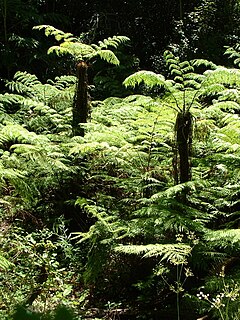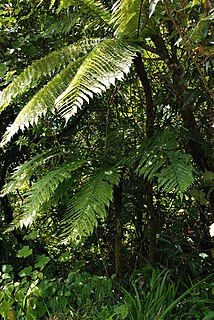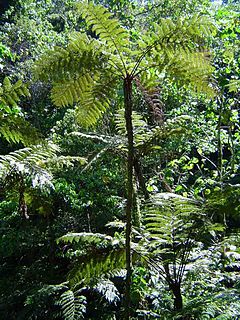
Cyathea cooperi, also known as the Australian tree fern, lacy tree fern, scaly tree fern, or Cooper's tree fern, is a tree fern native to Australia, in New South Wales and Queensland.

Onoclea is a genus of plants in the family Onocleaceae, native to moist habitats in eastern Asia and eastern North America. They are deciduous ferns with sterile fronds arising from creeping rhizomes in spring, dying down at first frost. Fertile fronds appear in late summer. Depending on the authority, the genus contains one to five species.
Cyathea archboldii is a species of tree fern native to New Guinea and Bougainville, where it is common in submontane rain forest at an altitude of 1000–3000 m. The trunk is erect and up to about 3 m tall. Fronds are bipinnate and 2–3 m long. The rachis may be purplish and has short spines and scales. The scales range in colour from pale to brown, to bicoloured and have fragile edges. Sori occur in two rows along each side of the pinnule midvein and are covered by firm indusia.
Cyathea camerooniana is a species of tree fern native to Sierra Leone, Cameroon, northern Angola and western Uganda, where it grows in montane forest at an altitude of 900–1200 m. The trunk is erect and 2–3 m tall. Fronds are pinnate and 2–3 m long. The rachis ranges in colour from dark to pale and has some hairs on the underside. The stipe is dark and is covered with scales throughout. Where scales have fallen, small warts are present. The scales are glossy brown and have a thin, dull edge. Sori occur at the forks of veins and are covered by thin indusia, which range in shape from cup- to saucer-like.

Cyathea capensis is a regionally widespread and highly variable species of tree fern. It is indigenous to Southern Africa and South America.

Cyathea cunninghamii, also known as the gully tree fern and slender tree fern, is a species of tree fern indigenous to New Zealand including North Island, South Island and Chatham Islands; also to Victoria, possibly New South Wales, southeastern Queensland and Tasmania in Australia. It grows in damp forest, often emerging from stream gullies and riverbanks. Brownsey noted that it has a lower tolerance for drought than other species of Cyathea. The erect trunk may be 20 m tall and is usually 6–15 cm in diameter, occasionally as much as 20 cm. Fronds are tri- to tetrapinnate and 3 m or more in length. The rachis and stipe are slender, black brown, warty and covered with brown scales. Sori occur along each side of the pinnule midvein and are covered by hood-like indusia. C. cunninghamii is an uncommon and slow-growing tree fern.

Cyathea dregei is a widespread species of tree fern in southern Africa.
Cyathea humilis is a species of tree fern native to Kenya, as well as the Usambara and Uluguru Mountains in Tanzania, where it grows in wet forest at an altitude of 1100–2000 m. The trunk of this plant is erect and 2–3 m tall. Fronds are pinnate and 1–2 m in length. Dead fronds are often retained in the typical variety, forming an irregular skirt around the trunk. The rachis and stipe are light brown in colouration. Scales are present towards the base of the stipe. They are dark, glossy, and have narrow, fragile edges. Sori occur at the forks of veins and are protected by thin, reduced indusia.
Cyathea hunsteiniana is a species of tree fern endemic to eastern New Guinea, where it grows in rain forest at an altitude of 1300–2000 m. This species has a slender, erect trunk up to 1 m tall and about 3 cm in diameter. Fronds are bipinnate and approximately 1 m in length. Scattered scales cover the stipe. They are dark brown in colouration and have a broad paler margin and fragile edges. Round sori are borne one or two per fertile pinnule segment. The sori are protected by deep, firm indusia that are cup-like in appearance.
Cyathea imrayana is a species of tree fern native to Dominica, Costa Rica, Panama, Venezuela, and Ecuador.
Cyathea javanica is a species of tree fern native to western Java and Sumatra, in Indonesia.
Alsophila is a section in the subgenus Cyathea. The name was originally applied to a genus of tree ferns which is now considered to be synonymous with Cyathea.

Cyathea is a subgenus in the genus Cyathea.

Cyathea glauca is a species of tree fern endemic to Réunion. Little is known about this species. C. glauca is not to be confused with Cyathea glauca used as a synonym of Cyathea mexicana.
Victoria, Australia contains approximately 32,000 hectares of temperate rainforest in various regions, which represents 0.14% of the State's total area. The areas with rainforest include: East Gippsland, Strzelecki Ranges, Wilsons Promontory, Central Highlands, and Otway Ranges. The rainforests vary between cool temperate, warm temperate, and mixed cool temperate.

Cyathea borbonica is a tree fern endemic to Mauritius, Réunion and the islands of the south-western Indian Ocean. There are several natural forms and varieties.

The spiny tree fern or sheshino is a tree fern and one of 326 species of Cyathea. It is readily identified by the fierce spines on its trunk, and is widespread in the tropical regions of Africa.












